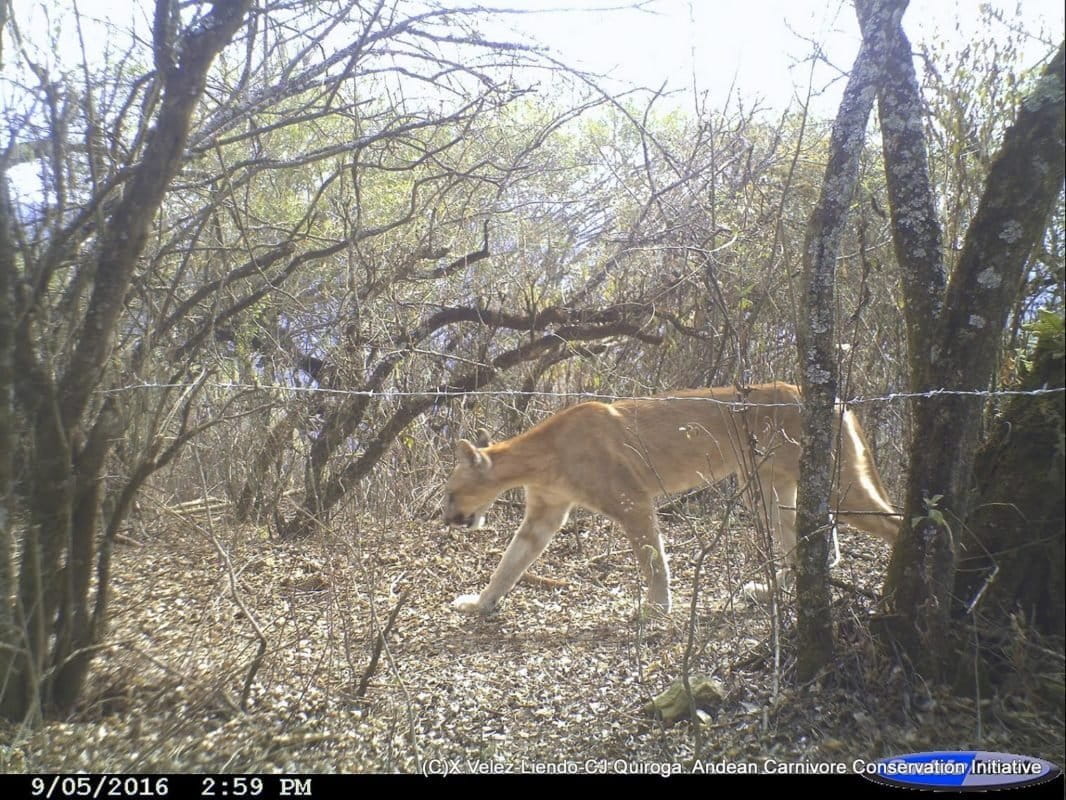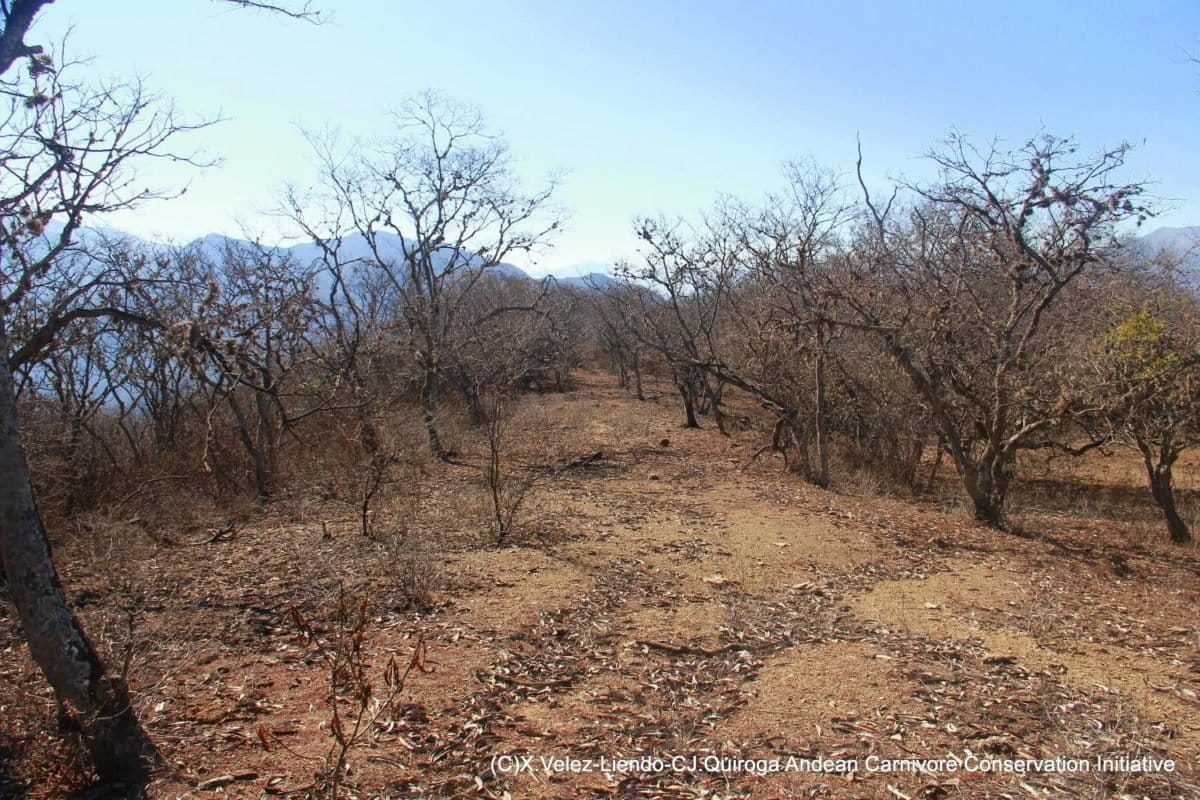- Climate change is placing stress on regional ecosystems and forcing species to compete for territory and food.
- Local governments in Bolivia are contemplating declaring the areas inhabited by bears protected municipal areas.
- The objective of the study is to generate high-quality scientific information to help mitigate conflicts between communities and bears, as well as other large carnivores.

The ancestor of the Andean bear (Tremarctos ornatus) is the Florida spectacled bear (Tremarctos floridanus), which migrated from the Florida peninsula a million years ago. But while the Florida spectacled bear is strictly carnivorous, its Andean descendent is not. Over millennia, it adapted to a more omnivorous diet that includes tough, fibrous vegetation like bamboo found in the Inter-Andean dry forests.
Ximena Velez-Liendo, an Andean bear specialist, and her research team are currently conducting the first population-based study of this species in the department of Tarija. Their research is funded by the Chester Zoo in England, comprises Bolivian scientists, Ph.D. students, and members of the Bolivian NGO PROMETA, and is supported by Oxford University’s WildCRU unit.
“It is the first region in Bolivia where we will conduct a population study with all scientific rigor necessary,” Velez-Liendo said. She told Mongabay Latam that her team is “installing camera traps, using DNA technology, we will collect hair and excrement from bears to make the population estimate.”
The Andean bear is found in Venezuela, Colombia, Ecuador, Peru and Bolivia. The species listed as Vulnerable on the IUCN Red List, and scientific consensus is that it is declining.
“These places, where we work, have the smallest populations and lowest densities. The numbers generated from next year onwards are going to be the first ones that we can safely use to say how many bears the area has,” said Velez-Liendo, who is considering using this methodology to survey Bolivia’s entire tropical forest region.
Climate change
The team led by Velez-Liendo decided to start their population census in the Bolivian Andean forests “because they are the least studied throughout its range, not only in Bolivia, but also in the region. Forests that have been widely used not only by people today, but by our ancestors due to the richness of the soil, are now considered part of the three most fragile ecosystems due to climate change.”
Research has shown that rising temperatures are displacing plants and animals, pushing the Amazon rainforest region up towards the Andean tropical forests.
“If we imagine an elevation profile, what is happening is that jaguars are rising, but bears cannot go higher because pumas are on an even higher elevation. So you have a conflict between these three species, and between them you have people with their livestock,” Velez-Liendo said during her presentation at the International Union for Conservation of Nature (IUCN) World Conservation Congress.

Velez-Liendo recalled that members of indigenous communities warned her for some time that something was wrong with the climate, that forests were changing and that they were not providing much fruit. They told her this made animals that are dependent on fruit for survival roam further in the search for food.
Forest fruit is an important resource for Andean bears, particularly for cubs that mature during the months of February, March and April – the short fruiting period in these latitudes.
“With changing weather patterns many of these forests are stressed: they either produce fruits all year-round or no fruit at all,” Velez-Liendo said. “This can lead to a decrease in the reproductive success of these animals.”
Conflict with humans
“In Latin America the interaction between natural protected areas and indigenous communities is very important, and even more so in Bolivia where local populations live inside or in the buffer zones of these areas,” said Alfonso Blanco, founder and the coordinator of special projects of PROMETA, an NGO dedicated to the conservation of nature and which is involved in the study.
Conflicts between jaguars, spectacled bears, pumas and indigenous communities is a fundamental element of the investigation, and it will investigate people’s attitudes, perception, and tolerance of Andean bears, and other large carnivores.

“Initially we want to see how the bears are affecting people, but so far what we are seeing is that the puma is the carnivore most conflicted,” said Velez-Liendo, who has worked with Bolivian indigenous communities and focused on the study of the Andean bear since 1999. “When pumas kill livestock, people get angry. And not only with the puma but with all the big animals such as bears, jaguars, foxes and other medium-size cats.”

Without food in the forest, Andean bears and pumas range closer to communities and sometimes attack livestock; in retaliation, people hunt them.
“In order to know whether the hunting of these animals as a form of retaliation for the loss of their livestock is sustainable or not, we must find out the total number of bears out there, because what people tell us is that they kill one or two bears per year,” Velez-Liendo said. “But if we are talking of about 15 different communities, we want to see if that number of dead bears negatively affects the entire population.”
In Bolivia, when one of these large carnivores attack or eats livestock, there is currently no compensation scheme for the animals’ owners.
Conservation efforts
“The municipality wants to declare these areas municipal protected areas, more so now that the Andean bear is here, a flagship species,” Alfonso Blanco of PROMETA told Mongabay Latam.
Rob Wallace, Director of the WCS Greater Landscape Program agrees that protected areas are important for the future of Andean bears.
“The most effective measure for the conservation of Andean bears in Bolivia is the national system of protected areas,” Wallace told Mongabay Latam.” Although the hunting of Andean bears is rare, it usually relates to the conflict between humans and wildlife, either by an affectation to their livestock or corn crops.”
Velez-Liendo and her team will be implementing conservation practices when conducting their survey.
“We will apply certain forms of mitigation with communities, one of them is the construction of electric fences because almost all the communities have access to solar panels,” Velez-Liendo said. “We’ll see if the use of these techniques improves the people’s attitude towards carnivores. Involving people in the community since the beginning makes the project successful.”

Still, many hurdles exist when it comes to bear conservation in Bolivia – particularly in the Bolivian Andes.
“Most of the funding goes to the Amazon region, to the greenest area, but little has been focused on these smaller areas that are very important to people,” Velez-Liendo said.
This story was reported by Mongabay’s Latin America (Latam) team and was first published in Spanish on our Latam site on September 22, 2016.